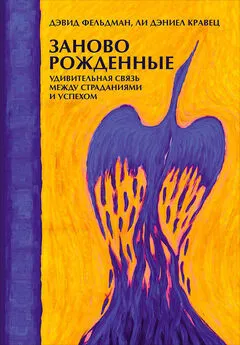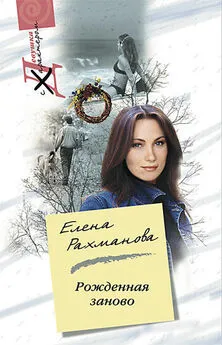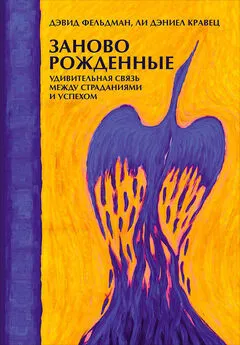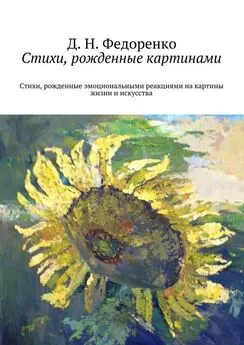Дэвид Фельдман - Заново рожденные
- Название:Заново рожденные
- Автор:
- Жанр:
- Издательство:Альпина нон-фикшн
- Год:2016
- Город:Москва
- ISBN:9785916714739
- Рейтинг:
- Избранное:Добавить в избранное
-
Отзывы:
-
Ваша оценка:
Дэвид Фельдман - Заново рожденные краткое содержание
Эта книга — больше, чем истории реальных людей, сумевших "родиться заново", пережив тяжелейшие травматические события, и превратить страдания в личный триумф. В их судьбах авторы прослеживают общие черты и закономерности. Известное изречение "То, что не убивает нас, делает нас сильнее!" здесь обретает практический смысл. Как не сломаться и найти новый смысл и цель существования? В чем разница между обоснованной надеждой и позитивным мышлением? Как умение прощать сказывается на физическом и душевном состоянии человека? Каким образом размышления о смерти могут помочь сделать жизнь лучше? Отвечая на эти вопросы, американские психологи Д. Фельдман и Л. Кравец убедительно показывают неслучайность связи между драматическими испытаниями и успехом.
Заново рожденные - читать онлайн бесплатно ознакомительный отрывок
Интервал:
Закладка:
Мы склоняем голову в знак уважения перед щедростью помогавших нам людей и организаций, включая Джона Карпентера, Адама Сэвиджа, Дэна Тэпстера, M5 Industries, Фонд мира Десмонда Туту (Desmond Tutu Peace Foundation), AMP’D Gear, проект The Before I Die Project и фонд The Bucket List Foundation. Также мы благодарим Международный паралимпийский комитет, институт Sigi Ziering Institute, Lucky Duck Productions, онкологический центр NYU Cancer Center, Американский музей холокоста чернокожих (America’s Black Holocaust Museum), ветеранскую организацию Iraq Afganistan Veterans of America, клиническую больницу при Стэнфордском университете (Stanford University Hospital and Clinics), Psychology Today, The Huffington Post, Cancer Care of New York, клинический онкологический центр NYU Clinical Cancer Center, больницу при Университете Джона Хопкинса (Johns Hopkins University Hospital) и Гопи Каллайил из Google Inc.
Значительную часть этой книги мы написали в творческом пространстве Writer’s Grotto в Сан-Франциско. У каждого места есть своя душа, а широкую душу Grotto не могут удержать никакие стены.
Библиография
Affleck, G., H. Tennen, S. Croog, and S. Levine. “Causal Attribution, Perceived Benefits, and Morbidity after a Heart Attack: An 8-Year Study.” Journal of Consulting and Clinical Psychology 55 (1987): 29–35.
American Cancer Society. Global Cancer: Facts and Figures, 2nd ed. Atlanta, GA: American Cancer Society, 2008.
Bonnano, G. A., and E. D. Diminich. “Annual Research Review: Positive Adjustment to Adversity — Trajectories of Minimal-Impact Resilience and Emergent Resilience.” The Journal of Child Psychology and Psychiatry 54 (2013): 378–401.
Bonanno, G. A., S. Galea, A. Bucciarelli, and D. Vlahov. “What Predicts Psychological Resilience after Disaster? The Role of Demographics, Resources, and Life Stress.” Journal of Consulting and Clinical Psychology 75 (2007): 671–82.
Calhoun, L. G., and R. G. Tedeschi. Facilitating Posttraumatic Growth: A Clinician’s Guide. Mahwah, NJ: Erlbaum, 1999.
Costanzo, E. S., C. D. Ryff, and B. H. Singer. “Psychosocial Adjustment among Cancer Survivors: Findings from a National Survey of Health and Well-Being.” Health Psychology 28 (2009): 147–56.
Dabney, L. “Polar Vision Expedition to Set Antarctic Record.” The Faster Times, October 27, 2011. http://www.thefastertimes.com/news/2011/10/27/polar-vision-expedition-to-set-antarctic-record/.
Davis, C. G., S. Nolen-Hoeksema, and J. Larson. “Making Sense of Loss and Benefiting from the Experience: Two Construals of Meaning.” Journal of Personality and Social Psychology 75 (1998): 561–74.
Elder, G. H., and E. C. Clipp. “Combat Experience and Emotional Health: Impairment and Resilience in Later Life.” Journal of Personality 57 (1989): 311–41.
Fontana, A., and R. Rosenheck. “Psychological Benefits and Liabilities of Traumatic Exposure in the War Zone.” Journal of Traumatic Stress 11 (1998): 485–503.
Frazier, P., A. Conlon, and T. Glaser. “Positive and Negative Life Changes Following Sexual Assault.” Journal of Consulting and Clinical Psychology 69 (2001): 1048–55.
Frazier, P., N. Keenan, S. Anders, S. Perera, S. Shallcross, and S. Hintz. “Perceived Past, Present, and Future Control and Adjustment to Stressful Life Events.” Journal of Personality and Social Psychology 100, no. 4 (2011): 749–65.
Frazier, P., H. Tennen, M. Gavian, C. Park, P. Tomich, and T. Tashiro. “Does Self-Reported Posttraumatic Growth Reflect Genuine Positive Change?” Psychological Science 20 (2009): 912–19.
Gean, A. D., and N. J. Fischbein. “Head Trauma.” Neuroimaging Clinics of North America 20, no. 4 (2010): 527–56.
Gernsbacher, M. A., R. W. Pew, L. M. Hough, and J. R. Pomerantz. Psychology and the Real World: Essays Illustrating Fundamental Contributions to Society. New York: Worth Publishers, 2011.
Gunty, A. L., P. A. Frazier, H. Tennen, P. Tomich, T. Tashiro, and C. Park. “Moderators of the Relation between Perceived and Actual Posttraumatic Growth.” Psychological Trauma: Theory, Research, Practice, and Policy 3 (2011): 61–66.
Helgeson, V. S., K. A. Reynolds, and P. L. Tomich. “A Meta-Analytic Review of Benefit Finding and Growth.” Journal of Consulting and Clinical Psychology 74 (2006): 797–816.
Herman, J. Trauma and Recovery: The Aftermath of Violence from Domestic Abuse to Political Terror. New York: Basic Books, 1992.
Kessler, R. C., A. Sonnega, E. Bromet, M. Hughes, and C. B. Nelson. “Posttraumatic Stress Disorder in the National Comorbidity Survey.” Archives of General Psychiatry 52 (1995): 1048–60.
Linley, P. A., and S. Joseph. “Positive Change Following Trauma and Adversity.” Journal of Traumatic Stress 17 (2004): 11–21.
McMillen, J. C., E. M. Smith, and R. H. Fisher. “Perceived Benefit and Mental Health after Three Types of Disaster.” Journal of Consulting and Clinical Psychology 65 (1997): 733–39.
Norris, F. H, M. J. Friedman, P. J. Watson, C. M. Byrne, E. Diaz, and K. Kaniasty. “60,000 Disaster Victims Speak — Part I: An Empirical Review of the Empirical Literature, 1981–2001.” Psychiatry: Interpersonal and Biological Processes 65 (2002): 207–39.
Pollard, C., and P. Kennedy. “A Longitudinal Analysis of Emotional Impact, Coping Strategies and Post-Traumatic Psychological Growth Following Spinal Cord Injury: A 10-Year Review.” British Journal of Health Psychology 12 (2007): 347–62.
Sims, T. “Trekking beyond Limits in Antarctica. The New York Times, October 21, 2011. http://www.nytimes.com/2011/10/22/sports/22iht-athlete22.html?_r=0.
Tedeschi, R. G., and L. G. Calhoun. “The Posttraumatic Growth Inventory: Measuring the Positive Legacy of Trauma.” Journal of Traumatic Stress 9 (1996): 455–71.
Tedeschi, R. G., and L. G. Calhoun. “Posttraumatic Growth: Conceptual Foundations and Empirical Evidence.” Psychological Inquiry 15 (2004): 1–18.
Vrana, S., and D. Lauterbach. “Prevalence of Traumatic Events and Post-Traumatic Psychological Symptoms in a Nonclinical Sample of College Students.” Journal Traumatic Stress 7 (1994): 289–302.
United Nations Development Fund for Women. “Unite to End Violence against Women: United Nations Secretary-General’s Campaign,” New York, 2008. http://www.un.org/en/women/endviolence/world.shtml.
World Health Organization. “Road Traffic Injuries.” Geneva, 2013. http://www.who.int/mediacentre/factsheets/fs358/en/.
Zolli, A., and A. M. Healy. Resilience: Why Things Bounce Back. New York: Free Press, 2012.
Armstrong, L. It’s Not about the Bike: My Journey Back to Life. New York: Berkley Trade, 2001.
Braver, R., senior correspondent. “Just How Powerful Is Positive Thinking?” [television broadcast]. CBS Sunday Morning, November 22, 2011.
Buckelew, S. P., R. S. Crittendon, J. D. Butkovic, K. B. Price, and M. Hurst. “Hope as a Predictor of Academic Performance.” Psychological Reports 103 (2008): 411–14.
Cheavens, J. S., D. B. Feldman, A. Gum, S. T. Michael, and C. R. Snyder. “Hope Therapy in a Community Sample: A Pilot Investigation.” Social Indicators Research 77 (2006): 61–78.
Chida, Y., and A. Steptoe. “Positive Psychological Well-Being and Mortality: A Quantitative Review of Prospective Observational Studies.” Psychosomatic Medicine 70 (2008): 741–56.
Coyne, J. C. “Was It Shown That ‘Close Relationships and Emotional Processing Predict Decreased Mortality in Women with Breast Cancer’? A Critique of Weihs et al.” Psychosomatic Medicine 70 (2008): 737.
Coyne, J. C., T. F. Pajak, J. Harris, A. Konski, B. Movsas, K. Ang, and D. W. Bruner. “Emotional Well-Being Does Not Predict Survival in Head and Neck Cancer Patients: A Radiation Therapy Oncology Group Study.” Cancer 110 (2007): 2568–75.
Coyne, J. C., M. Stefanek, and S. C. Palmer. “Psychotherapy and Survival in Cancer: The Conflict between Hope and Evidence.” Psychological Bulletin 133 (2007): 367–94.
Coyne, J. C., H. Tennen, and A. V. Ranchor. “Positive Psychology in Cancer Care: A Story Line Resistant to Evidence.” Annals of Behavioral Medicine 39 (2010): 35–42.
Curry, L. A., C. R. Snyder, D. L. Cook, B. C. Ruby, and M. Rehm. “Role of Hope in Academic and Sport Achievement.” Journal of Personality and Social Psychology 73 (1997): 1257–67.
Ehrenreich, B. Bright-Sided: How Positive Thinking Is Undermining America. New York: Henry Holt, 2009.
Feldman, D. B., and D. E. Dreher. “Can Hope Be Changed in 90 Minutes? Testing the Efficacy of a Single-Session Goal-Pursuit Intervention for College Students.” Journal of Happiness Studies 13 (2012): 745–59.
Feldman, D. B., K. L. Rand, and K. Kahle-Wrobleski. “Hope and Goal Attainment: Testing a Basic Prediction of Hope Theory.” Journal of Social and Clinical Psychology 28 (2009): 479–97.
Feldman, D. B., and C. R. Snyder. “Hope and the Meaningful Life: Theoretical and Empirical Associations between Goal-Directed Thinking and Life Meaning.” Journal of Social and Clinical Psychology 24 (2005): 401–21.
Gallagher, B. “Maarten van der Weijden: Don’t Call Me Lance Armstrong.” The Daily Telegraph, August 21, 2008. http://www.telegraph.co.uk/sport/olympics/2594982/Maarten-van-der-Weijden-Dont-сall-me-Lance-Armstrong.html.
Goodwin, P., M. Leszcz, M. Ennis, J. Koopmans, L. Vincent, H. Guther, and J. Hunter. “The Effects of Group Psychosocial Support on Survival in Metastatic Breast Cancer.” The New England Journal of Medicine 345 (2001): 1719–26.
Gore-Felton, C., and D. Spiegel. “Enhancing Women’s Lives: The Role of Support Groups among Breast Cancer Patients.” Journal for Specialists in Group Work 24 (2008): 274–87.
Heckhausen, J., C. Wrosch, and W. Fleeson. “Developmental Regulation before and after a Developmental Deadline: The Sample Case of ‘Biological Clock’ for Childbearing.” Psychology and Aging 16 (2001): 400–13.
Hull, S. J. “Perceived Risk as a Moderator of the Effectiveness of Framed HIV-Test Promotion Messages among Women: A Randomized Controlled Trial.” Health Psychology 31 (2012): 114–21.
Irving, L. M., C. R. Snyder, and J. Cheavens. “The Relationships between Hope and Outcomes at the Pretreatment, Beginning, and Later Phases of Psychotherapy.” Journal of Psychotherapy Integration 14 (2004): 419–43.
Janz, N. K., and M. H. Becker. “The Health Belief Model: A Decade Later.” Health Education Quarterly 11 (1984): 1–47.
Lieven, P., W. Frank, B. Gerben, and W. Bernasco. “Perceived Sanction Risk, Individual Propensity and Adolescent Offending: Assessing Key Findings from the Deterrence Literature in a Dutch Sample.” European Journal of Criminology 8 (2011): 386–400.
Miller, G. E., and C. Wrosch. “You’ve Gotta Know When to Fold ’Em: Goal Disengagement and Systemic Inflammation in Adolescence.” Psychological Science 18 (2007): 773–77.
Moser, R. P., K. McCaul, E. Peters, W. Nelson, and S. E. Marcus. “Associations of Perceived Risk and Worry with Cancer Health-Protective Actions.” Journal of Health Psychology 12 (2007): 53–65.
Читать дальшеИнтервал:
Закладка:







